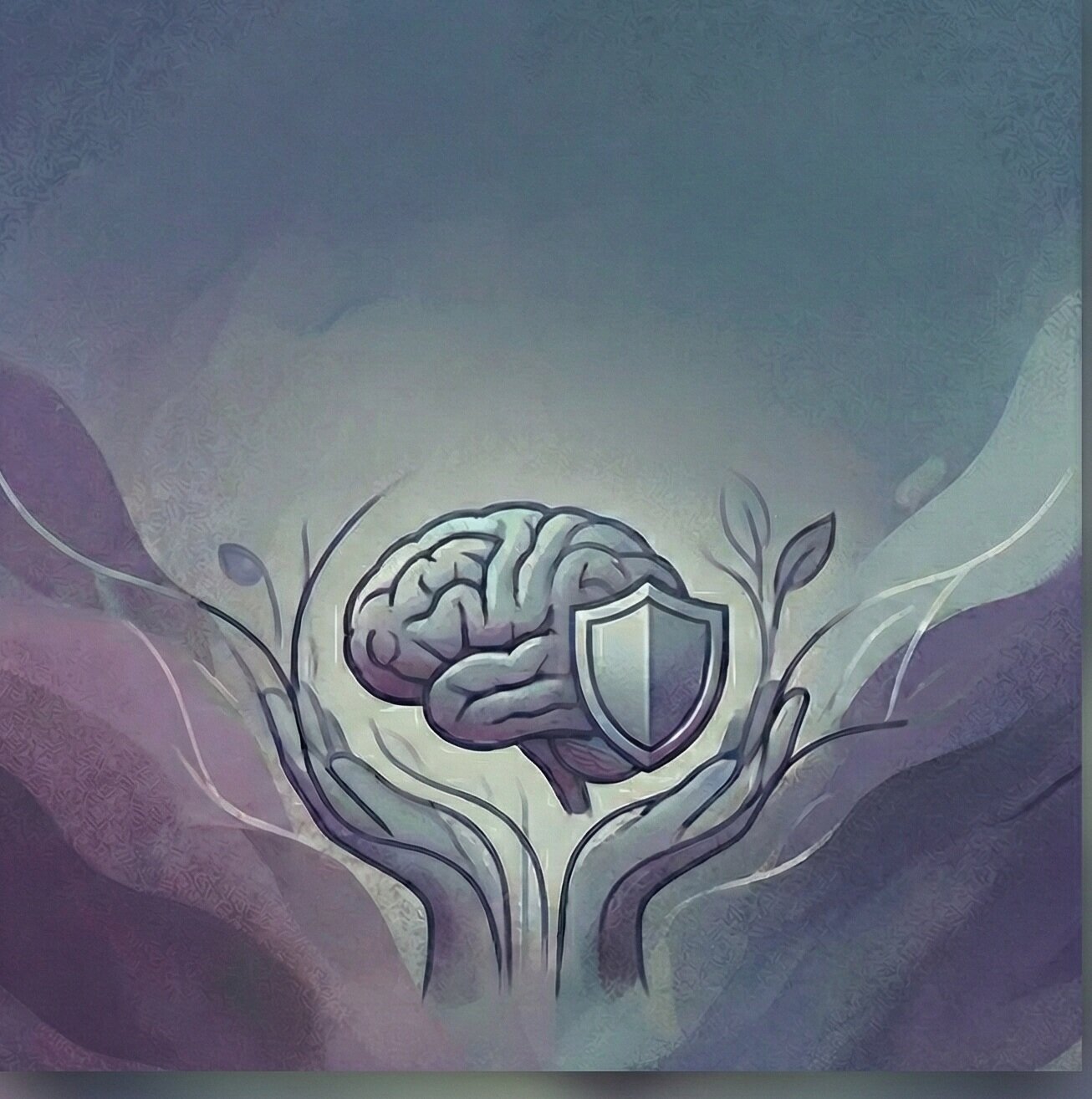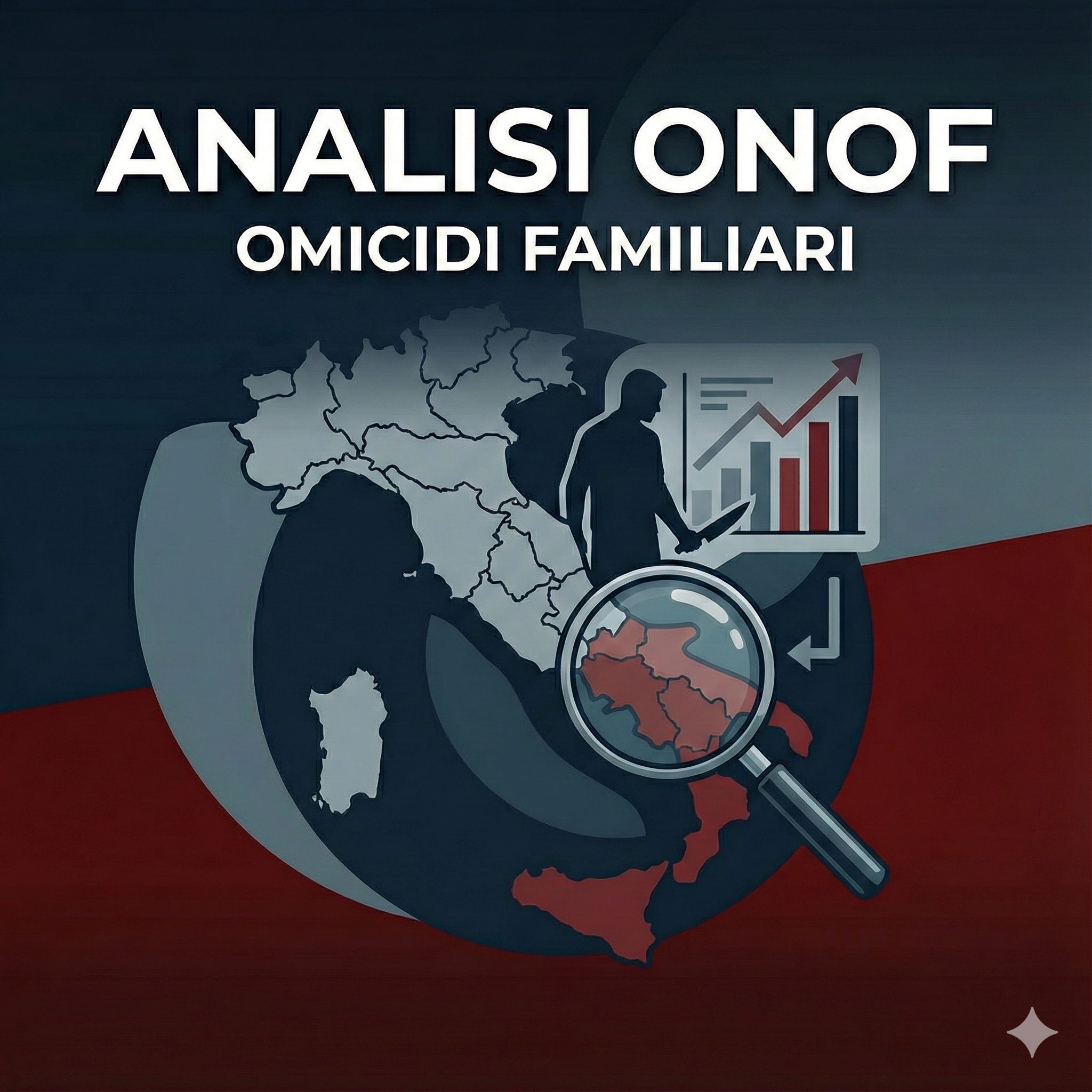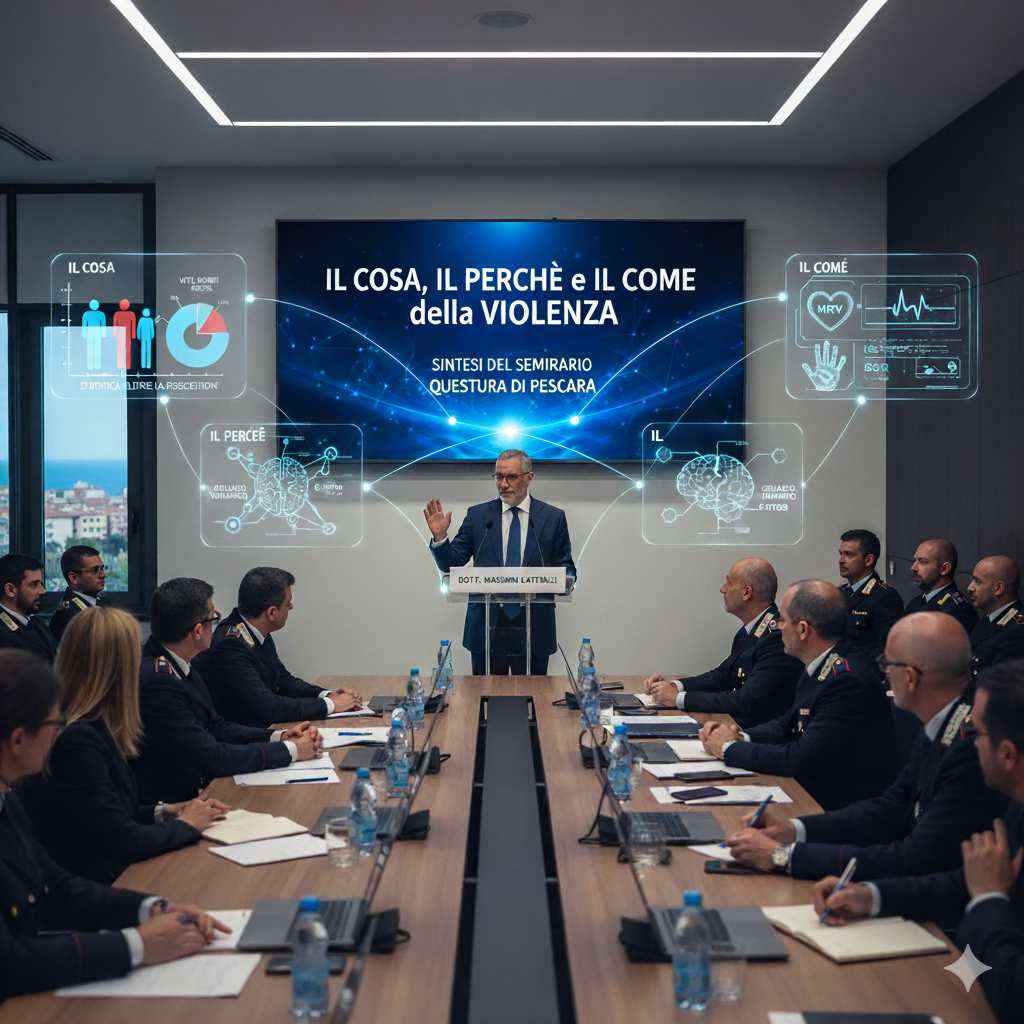Seminar Summary – rome police headquarters (Questura di Roma). violence prevention: the evidence-based and trauma-oriented approach
A crucial meeting for the fight against violence took place on November 21, 2025, in the setting of the Augusto Cocola Hall at the Rome Police Headquarters: the seminar 'Violence Prevention: The Evidence-Based and Trauma-Oriented Approach'.
Organized in synergy with the Italian Association of Psychology and Criminology (A.I.P.C.), the event highlighted the necessity of a scientific approach ranging from understanding trauma in the victim to analyzing the dynamics of the perpetrator.
The training day saw the active participation of approximately fifty specialists, including over thirty State Police (Polizia di Stato) officers and more than fifteen sector experts, gathered to acquire new intervention tools based on the most recent scientific evidence.
Dr. Franco Spinelli
The welcome and opening of the seminar were entrusted to the professionalism of Dr. Franco Spinelli (Training Office – Professional Courses, Updates, and Training of the Rome Police Headquarters), who introduced the proceedings by reaffirming the value of the synergy between law enforcement and sector experts.
Keynote Speaker: Massimo Lattanzi
Psychologist, Psychotherapist, A.I.P.C.
A new lens on violence: from "guilt" to "biological fracture"
The opening intervention, the result of close operational synergy between AIPC (research), CIPR (clinical practice), and ONOF (data observation), proposed a radical paradigm shift to the audience. The goal was to move beyond a purely behavioral reading of violence to descend into the depths of its neurobiological roots, tracing a common thread connecting the earliest life experiences to violent outcomes in adulthood.
The silent origin: prematurity as a neuro-affective crisis The journey begins with an often-overlooked revelation: preterm birth should not be considered merely a medical event concluding with hospital discharge, but as a deep neuro-affective crisis. The incubator, a technology indispensable for biological survival, paradoxically represents a hostile sensory environment that prevents reparative human contact. In this very delicate phase, different traumatic trajectories are generated:
- CB-PTSD (Parents): The parent, terrified by potential loss, experiences post-traumatic stress that paralyzes or emotionally numbs them, rendering them unable to attune with the child.
- C-PTSD (Neonate): The child, subjected to repeated micro-traumas (lights, needles, noises) without the refuge of an embrace, develops Complex Trauma. Their body learns a terrible lesson: the world is a place of "danger without resolution."
The neurobiology of trauma: when the brain goes "offline" What happens inside the individual exposed to this early toxic stress? A measurable "biological fracture" occurs in the Central Nervous System. The brain undergoes a functional split: the amygdala (our threat radar) remains stuck in a position of perpetual hyper-activation, seeing danger everywhere. Simultaneously, the prefrontal cortex—the area responsible for logic, planning, and impulse control—receives fewer resources and literally goes "offline." The result is an individual who reacts to stimuli with archaic survival reflexes, bypassing reasoning.
The Collapse of the Autonomic Nervous System (ANS) The direct consequence of this fracture is the loss of homeostasis, or internal balance. The traumatized subject loses the ability to self-regulate and oscillates violently, outside their "window of tolerance," between two dysfunctional extremes:
- Hyper-arousal (The Stuck Accelerator): A dominance of the sympathetic system preparing for fight or flight. It manifests as rigidity, explosive anger, and, instrumentally, high skin conductance.
- Hypo-arousal (The Broken Brake): A dorsal vagal dominance leading to collapse, freezing, or dissociation. Here the system "shuts down" to survive pain, evidenced by low Heart Rate Variability (HRV).
All this happens because, at the origin, co-regulation failed: that "auxiliary brain" (the calm parent) who teaches the child how to manage fear was missing.
Making the invisible visible: The ASVS protocol To avoid relying solely on words, which are often deceptive or insufficient, the intervention presented the ASVS Protocol (AIPC Scientific Violence Screening). This integrated approach combines clinical assessment (via the SVITR scale to map emotional systems) with objective Biofeedback measurement. Thanks to this technology, it is possible to visualize the "biological signature" of trauma: we see in real-time if the "vagal brake" (HRV) is broken or if the "sympathetic accelerator" (Conductance) is always pressed. These data objectify that dysregulation is not a "difficult" character trait, but real physiological damage.
The violent act and deprivation trauma The conclusions were stark: the violent act, in this framework, should not be read as a logical and premeditated choice, but as a somatic "short circuit." It is the inevitable explosion of a nervous system saturated with tension that no longer has inhibitory brakes. Finally, space was given to Deprivation Trauma, the trauma of the "void." Unlike active abuse, this stems from the chronic absence of attunement and comfort ("relational nutrients"). Those who grow up in this void interiorize the idea of being "invisible", a deep conviction that structurally predisposes them to Complex Post-Traumatic Stress Disorder (C-PTSD) and future pathological relational dynamics.
Speaker: Dr. Giuseppe Molinari
A contribution of absolute importance was offered by Dr. Giuseppe Molinari, head of the IV Section of the Mobile Squad (Squadra Mobile), who traced a valuable historical-operational overview of the genesis of the section specialized in combating gender-based violence.
Dr. Molinari illustrated the complex investigative dynamics of the last century, highlighting the difficulties of operating in a regulatory context limited only to the category of harassment and supported by purely 'analog' instrumentation. The intervention was distinguished by the ability to weave professional rigor with deep personal sensitivity, recalling the dual experience of being an official and a parent. His presentation, charged with emphasis and emotional participation, received heartfelt applause from all operators present.
Speaker: Tiziana Calzone
Psychologist, Psychotherapist, A.I.P.C.
From toxic relationships to conscious parenting
Giving body and voice to relational suffering was Dr. Tiziana Calzone, psychologist and psychotherapist of A.I.P.C., who guided the audience through a journey into the clinical dynamics observed in work with individuals, couples, and families. Her intervention highlighted how violence does not spring from nothing but often sprouts in the fertile ground of distorted communication.
Dr. Calzone placed a crucial emphasis on communicative coherence, contrasting it with the insidious nature of affective manipulation and gaslighting. Gaslighting was described not as a simple argument, but as lucid and cruel psychological violence: a dismantling of the other's reality that leads the victim to doubt their own memory and mental sanity, making them dependent on the abuser's manipulated "truth."
The provocation: a "points-based license" for parents
The beating heart of the intervention touched on primary prevention, with a provocative but necessary proposal: the idea of a "points-based license" for future parents. Dr. Calzone strongly emphasized that giving birth is not enough to be a parent; one must be a "resolved" individual. Otherwise, the risk is projecting unmet needs onto the child, creating two dramatic scenarios:
- The child burdened with expectations and results, forced to achieve what the parent did not.
- The "adapted child," the one who learns not to disturb, to make themselves "invisible" just to allow the parents to continue their lives undisturbed.
Here the intervention intertwined perfectly with the scientific data presented by Massimo Lattanzi, recalling that this "void" of attunement is not neutral but creates "Deprivation Trauma." As recalled by Lattanzi with a striking phrase that shook the room: "Trauma is not a psychological choice, but a measurable biological fracture." That invisible child risks developing chronic dysregulation, since "the violent act or withdrawal is not a choice, but a neurobiological short circuit."
The "budding persecutor" and the school challenge
Finally, the gaze shifted to the school, defined as the first trench for the early identification of distress. A.I.P.C.'s field experience has brought to light alarming cases of "budding persecutors": pre-adolescents who already show behavioral patterns of control and dominance. Dr. Calzone highlighted an uncomfortable truth: in these cases, the hardest work is not with the boy, but with the parents. Often unable to see or accept their child's drift, these adults represent the biggest obstacle to treatment, confirming that true prevention must start long before distress explodes into persecutory conduct.
As reiterated by the data presented by Lattanzi, ignoring these signals is dangerous: early exposure to coercive or neglectful styles increases the risk of interpersonal violence in adulthood by 30-40%, transforming today's pain into tomorrow's crime news.
Speaker: Carmen Pellino
Psychologist-Psychotherapist specialized in EMDR
The invisible roots of violence: the weight of parental control
The subsequent intervention shifted the focus from biological bases to educational dynamics, addressing the crucial theme of How parental control influences dynamics in victims and perpetrators of violence. The analysis highlighted a subtle but powerful mechanism: the way we were "regulated" as children often determines how we will regulate our relationships as adults.
The boundary between guidance and dominion The discussion started with a necessary distinction. Parental control is not absolutely negative: there exists an adaptive form, made of protection and clear rules that guide growth. However, the terrain becomes dangerous when this control slips into dysfunction: that is, when it becomes suffocating hyper-control, coercion, or, worse still, unpredictability. It is in these educational folds that future vulnerabilities are structured.
Two sides of the same coin: victim and perpetrator The intervention outlined two distinct developmental trajectories originating from the same dysfunctional matrix:
- The Victim profile: Those who become victims often come from a family context where control was mixed with devaluation and unpredictability. Growing up without knowing "what the weather will be like" at home leads to developing low self-esteem and deep emotional dependence. The victim learns that the other is intrinsically threatening and, to survive, interiorizes fear, developing difficulties in asserting their boundaries (assertiveness).
- The Perpetrator profile: Specularly, the perpetrator of violence often emerges from families characterized by rigid, punitive control and inflexible rules. In this cold climate, where empathy is missing, the child learns that power is the only valid currency in relationships. As an adult, they will replicate this schema through impulsivity and prevarication: if the victim interiorizes fear, the perpetrator interiorizes power as the only form of regulation.
Evidence from A.I.P.C. research To substantiate these theories, data from research conducted by the Italian Association of Psychology and Criminology on a sample of 115 subjects, including currently detained offenders, were presented. The results are eloquent:
- Victims recall significantly more devaluing and unpredictable parents.
- Perpetrators report experiences of rigidly punitive control, accompanied by a chronic absence of emotional support.
Conclusions The final message of the intervention was of great impact: although behavioral outcomes seem opposite—the submission of the victim versus the dominance of the perpetrator—both profiles share the same tragic root. They are both prisoners of a pathological relational model, founded on disequilibrium and deep emotional fragility. Violence and submission, therefore, are nothing but two different responses to the same educational failure.
Conclusions: A Bridge Between Science and Operations
Thus concludes a day of extraordinary educational and human value at the Sala Cocola of the Rome Police Headquarters. The seminar represented much more than a simple professional update: it was a shared journey into the deep roots of violence.
From the institutional welcome by Dr. Franco Spinelli, who opened the proceedings by underscoring the importance of continuous training, we descended into the depths of the "biological fracture" of trauma with Dr. Massimo Lattanzi and Dr. Tiziana Calzone. Through their words, we understood that the violent act is not always a choice, but often the tragic outcome of a dysregulated nervous system and an ancient relational "void." The picture was completed with the intervention of Dr. Carmen Pellino, who illuminated how dysfunctional parental control can silently shape future profiles of victims and offenders. Giving concreteness and historical memory to these theories was the vibrant testimony of Dr. Giuseppe Molinari, who reminded us all how the intuition and humanity of the investigator remain irreplaceable tools, even in the digital age.
A protagonist audience The true success of the event, however, lies not only in the quality of the presentations but in the extraordinary response of the audience. Attention remained extremely high throughout the proceedings, transforming passive listening into a lively and constructive dialogue. The numerous questions, punctual interactions, and exchange of experiences between State Police operators and professionals present demonstrated how deeply felt the need is to unite forces and languages to combat violence.
Acknowledgments A dutiful and heartfelt thank you goes to Mr. Questore, for making this important moment of institutional dialogue possible. We also want to address a special thought and thank you to Avv. Elia Cursaro, who unfortunately, due to unavoidable institutional commitments, could not be physically present, but whose closeness to the project was fundamental.
A particular round of applause goes to the "hidden engine" of this day: the Psychology Interns of A.I.P.C. — Alice Russo, Caterina Ventura, Federico Maroli, Vanessa Alterino, and Francesca Candus. Their active contribution, enthusiasm, and professionalism demonstrated in the organization were decisive for the perfect success of the event.
An invitation to the future The training does not end here. We invite all participants and interested persons to keep this exchange alive by navigating the Association's website: www.associazioneitalianadipsicologiaecriminologia.it
You will find new articles, updated research, and in-depth columns to continue reading reality with new, increasingly competent, and aware eyes.
Thank you to everyone for making this day memorable.



